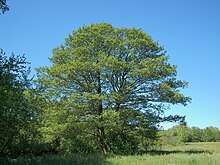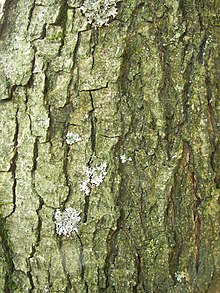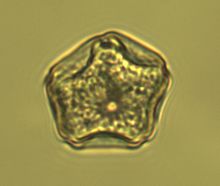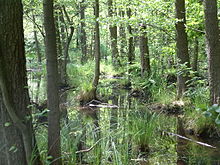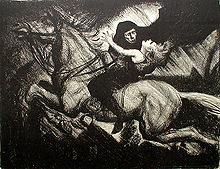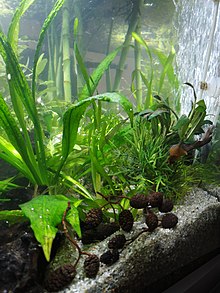Black alder
| Black alder | ||||||||||||
|---|---|---|---|---|---|---|---|---|---|---|---|---|
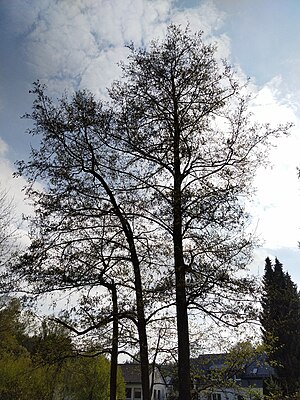
Black alder in spring near the Aubach in Reichshof. |
||||||||||||
| Systematics | ||||||||||||
|
||||||||||||
| Scientific name | ||||||||||||
| Alnus glutinosa | ||||||||||||
| ( L. ) Gaertn. |
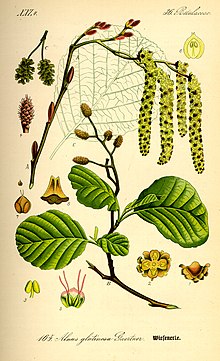
The black alder ( Alnus glutinosa ), also in the spelling alder , is a medium sized deciduous tree of the genus of alder and belongs to the family of the birch family (Betulaceae). Other common names for the black alder are Eller or Else . Because freshly cut wood turns red, it is also called red alder - a name that is also used for the red alder ( Alnus rubra ) native to North America .
The black alder is widespread throughout Europe and is only missing in northern Scandinavia and Iceland. It can be easily recognized by its cone-like fruiting stems that remain on the tree over the winter, by the leaves that are rounded or notched at the front, the bare shoots and the black-brown, torn bark of older trees. Its comparatively low maximum age of 120 years, its rapid growth and the high light requirement of young trees indicate that the species is a pioneer tree species . At most locations, it is therefore no longer able to compete with other species.
However, it is superior to other deciduous trees in extremely wet, groundwater-affected or temporarily flooded locations and also forms pure stands there, for example in the Spreewald south of Berlin. Since the alder is often found in damp, also swampy areas, which were considered scary, popular belief often associates it with the devil and witchcraft. Alder wood is extremely durable under water. It was therefore used for pile dwellings as early as the Neolithic Age. Venice was also built on oak and alder wood. The black alder was named Tree of the Year 2003 in Germany .
description
Manifestation
The black alder is a deciduous deciduous tree and reaches a height of 30 meters, rarely up to 40 meters with trunk diameters of up to one meter. The trunk is straight and extends to the top of the crown. The crown shapes are very different within the distribution area, usually it is described as pyramidal. The syllepsis , which occurs well into old age, is striking (formation of side shoots without a bud stage); On younger trees, the sylleptic side shoots can even branch sylleptically again. The black alder reaches a comparatively young age at 100 to 120 years; Trees from stick rashes do not even reach this age.
Bark and wood
The bark of young trees is greenish-brown, shiny, smooth and shows numerous transverse cork pores . In older trees it develops into a dark gray to blackish brown and split into small, angular pieces by cracks. The tannin content of the bark is around 9 percent.
Alder wood belongs to the sapwood species, so heartwood and sapwood are of the same color. The wood has scattered pores, the annual rings are barely visible. After felling, the wood initially appears whitish to reddish, but changes color to yellow-red due to oxidation . One speaks of the “bleeding” of the alder. Typical are radially arranged pseudomullet rays , which consist of several closely spaced, narrow wood rays between which no vessels appear.
root
The black alder forms a deep heart-root system . However, it lacks the strong main lateral roots common in other tree species, around 70 to 90 percent of the roots are vertical roots. The areas between the trees are therefore only weakly rooted. Most of the root mass consists of roots between 0.5 and 3 centimeters in diameter. Fine roots are found in clusters in the well-ventilated topsoil and at the ends of the vertical roots. Overall, however, only a few fine roots are formed. Air is exchanged through large cork pores at the base of the trunk and the roots close to the surface. Only prolonged flooding of the trunk base can cause the alder to die. In the upper soil areas, the alders form root nodules, pin-head to apple-sized swellings made up of short, thick, forked roots. They house the Frankia alni bacterium, which lives symbiotically with the alder and binds the nitrogen in the air .
Buds, leaves and young shoots
The egg-shaped buds are arranged in a spiral, are up to 6 millimeters long and 3 millimeters wide and have 2 to 3 millimeters long stems. They are covered by three scale-shaped leaves, which are formed from two stipules and the lowest leaf. When sprouting, the bud scales lengthen to more than twice their original length. They are brown-violet and sticky due to a wax coating and sometimes frosted bluish.
The leaves are 4 to 9 centimeters, rarely up to 3 centimeters long and 3 to 7 centimeters wide. They are obovate to rounded, the leaf margin is roughly double-sawn. The petiole becomes 1 to 2.5 inches long. The base of the leaf blade is broadly wedge-shaped, the tip is truncated to marginalized, which distinguishes the species from other Central European alders, as does the three- strand leaf trace . The upper side of the leaf is dark green, glabrous and initially sticky, the underside of the leaf is slightly lighter and also glabrous. The stipules are blunt, scale-like and fall off early in the year. The young shoots are initially hairy and sticky. In autumn the leaves are shed while they are still green.
Flowers and fruits
The black alder begins to bloom when it is around ten years old, and often only after 40 years in existence . Both male and female flowers are on a tree, so it is single-sexed ( monoecious ). The flowers are pollinated by the wind ( anemophilia ). The male inflorescences are 5 to 10 centimeters long catkins on 10 to 15 millimeter long stems. They consist of three-flowered dichasias , each with a bract and four bracts . Usually three to five male kittens, also arranged dichasally, stand together and thus form the entire inflorescence. At its base there are usually three to five clustered, approximately 5 millimeter long female catkins on 2 to 3 millimeter long stems. The female catkins are also composed of dichasally arranged inflorescences with a bract and four bracts, but the central flower is missing and the perigone of the other flowers has receded. At the base of both male and female catkins, hermaphrodite flowers can appear, whereby the hermaphrodite flowers can reach maturity on female infructescence. The black alder is a distinct early bloomer, both the male and female inflorescences are created in the previous year, and pollination takes place before the leaves unfold. The male flowers of a tree develop clearly before the female ( proterandry ). After mild winters, the black alder can start to bloom as early as January; the typical bloom time is from February to April.
The bracts and the four bracts of the female flowers grow together into five-part scales as the fruits ripen. The individual scales of an inflorescence grow together to form 1.5 to 1.8 centimeters long woody cones that are otherwise unusual in deciduous trees. Three brown, flattened, single-seeded nuts with a diameter of 1 to 2 millimeters are formed per scale . Two styluses remain at the top of the fruit. At the side they are provided with corky, air-filled protrusions, which increase the swimming ability. Parthenocarpic fruits are sometimes formed, which are the result of unfertilized female flowers. The thousand grain mass is 1.4 grams. They ripen from September to October and fall out of the cones during autumn, winter and spring. They are spread by wind and water. Since the size of the wings is smaller than that of gray and green alder, their seeds sink to the ground faster at about 0.17 meters per second, so the average distance from the wind is 30 to 60 meters. Propagation by water is more effective, the seeds are transported further and reach well-watered soils. The seeds remain viable in the water for up to twelve months. The cones stay on the tree throughout the winter and are a source of food for many bird species such as siskins and goldfinches during this season .
Chromosome number
The chromosome number of the black alder is 2n = 28.
Propagation and germination
The black alder reproduces generatively by seeds. It germinates epigeously and forms two small, egg-shaped cotyledons , very rarely three cotyledons are formed. The primary leaves, which are already alternately arranged, are notched and, like all six leaves from the first year, are pointed. The black alder also reproduces vegetatively through stick rash , but does not form roots . The ability to multiply through stick rash persists up to the age of 60.
Distribution and location requirements
The black alder probably did not survive the last Ice Age north of the Alps, but survived the cold spell over a large area on the Mediterranean. From there it migrated back to Central Europe west and east of the Alps, particularly quickly along the larger rivers. Large areas of it are only represented in Central Europe late, towards the end of the early warm season . The reasons for this were the pressure of competition, the not yet completed silting up of the lakes and the not yet sufficiently advanced formation of fens . Only in the middle warm season did it spread to damp and wet locations. However, by means of drainage measures and the creation of meadows, the population was pushed back again by humans.
The black alder is widespread throughout Europe, but is also found in Asia and Africa. In the north, the spread ends where the monthly mean temperatures are more than half a year below zero degrees Celsius. In Sweden the limit is 65.5 degrees north latitude, in Russia in the area around Lake Ladoga and Lake Onega . The eastern border in Asia runs from western Siberia south to western and northern Anatolia and through northern Iran to Gorgan on the Caspian Sea . In the south their distribution area extends to the North African Atlas Mountains . In Germany there are large contiguous forests in the north German lowlands , for example in the Spreewald near Berlin . It was introduced into the United States and South Africa from Europe.
The black alder usually grows in low altitudes, but it can be found in low mountain ranges , for example in the Northern Alps up to 1150 meters above sea level, in the Pyrenees up to 1200 meters and in the Central Alps up to 1800 meters. It colonizes wet locations and is considered to be bog and swamp wood. It thrives in swamp forests , on damp and wet meadows and in swamp locations and prefers partially shaded, cool locations. In the Allgäu Alps, it barely rises above 1,100 meters above sea level.
The black alder is listed as Least Concern on the IUCN Red List .
ecology
The black alder is a groundwater pointer, peat builder, nitrogen collector and a deep and intensive rooter.
Socialization
The black alder also thrives in wet and often flooded locations and is competitive here with other tree species. It dominates the following forest communities (after Erich Oberdorfer ):
- Alder stream floodplain forest (Stellario nemori-Alnetum) in the floodplain of brooks in the low mountain range on alluvial soils rich in silicate .
- Alder swamp forest (Circaeo-Alnetum glutinosae) on moderately wet, mineral soft soils with a medium base supply , for example on the edges of bog . The base supply is not sufficient for the common ash to dominate .
- Alder quarry forest (Carici elongatae-Alnetum glutinosae) thrives on meso- to eutrophic peat soils and is characterized by bog. The groundwater reaches close to the surface; in winter it comes to overflow, in summer to superficial desiccation.
symbiosis
The black alder forms root nodules in which the elemental nitrogen in the air is bound and thus usable for the plant. This is done by one as actinorhizal plant called symbiosis with the bacterium Frankia alni . The bacterium lives in the root nodules and is nourished by the alder; In return, it provides the host plant with nitrogen compounds, which it can form directly from the nitrogen in the air using the enzyme nitrogenase . If alders without nodules are cultivated in a nitrogen-free nutrient solution, they die; Alder with nodules, however, develop almost normally. The amount of nitrogen bound annually depends on the nitrogen content of the soil; the symbiosis performance increases for soils that are poor in nitrogen. The extent of nodule formation also depends on the pH of the soil and reaches its maximum at a pH of 5. An annual nitrogen fixation of around 70 kilograms per hectare was measured for an intact alder forest. In this process, 70% of the nitrogen in the biomass was obtained by fixing nitrogen from the air. Other investigations showed maximum values of 200 to 300 kilograms per hectare. The proportion of nitrogen in the leaves is around 3%. The nitrogen compounds are not removed from the leaves at the end of the vegetation period and therefore get into the soil when the leaves are shed and increase its nitrogen content.
With several genera of soil fungi, the black alder is a root symbiosis ( ectomycorrhizal a), so with Täublingen ( Russula ) such as alder Täubling , milk Lingen ( Lactarius ) as Großsporiger alder Milchling ( Lactarius cyathuliformis ) and Olivbrauner alder Milchling ( Lactarius obscuratus ), Swamp carvings ( Naucoria ), hair veils ( Cortinarius ) and Kremplingen ( Paxillus ). The alder brood is also a typical mycorrhizal partner. Rarely Endomykorrhizen or arbuscular Mikorrhizen on.
pathology

The black alder is particularly by appearing only at the end of the 20th century known as Phytophthora alni risk. The egg fungus Phytophthora alni causes root and stem rot particularly on the black alder, but also on the gray alder, the green alder and the heart-leaved alder . The stem rot can lead to the death of trees after several months, but it can also drag on for years. The disease was first described in the south of England in 1993. It has since spread to Germany (first observed in 1995), Austria, France, Belgium, Italy, Ireland, Hungary, the Netherlands and Sweden. Symptoms are poor foliage, dead branches and particularly small, light-colored leaves. Black-brown, mostly oozing spots that appear on the base of the trunk are typical. The wood lying under the attacked areas is discolored from dark brown to reddish brown and is clearly differentiated from the healthy light wood. The infection occurs through wounds on the base of the trunk, through the hair root system or through cork pores. Analyzes have shown that the Phytophthora alni pathogen has only recently developed through hybridization.
The alder death caused by Phytophthora alni must be differentiated from the "classic" alder death. In the second half of the 19th and early 20th centuries, 5- to 20-year-old alder trees were increasingly damaged by the alder-top fungus Valsa oxystoma . The infestation caused growth to slow down, combined with an increased formation of cones that reached maturity too early. The subsequent death of the trees then started from the tops and not from the base of the trunk (plait drying). The reason for the increased occurrence of the disease was later given to abiotic conditions in connection with the wrong choice of origin of the plant material.
The tube fungus Taphrina tosquinetii triggers a curling disease that leads to blister-like swellings and shell- shaped curvatures of the leaves and deformation of the shoots. The Common Hallimasch ( Armillaria mellea ) and the Alder Schillerporling ( Inonotus radiatus ) are weak parasites .
Of the insect species , the alder weevil ( Cryptorrhynchus lapathi ) can cause considerable damage by eating under the bark and in the wood. Larvae of the blue alder leaf beetle ( Agelastica alni ) can devour entire trees. The ore-colored alder leaf beetle ( Melasoma aenea ) hardly causes any damage.
Systematics
The black alder belongs to the genus of alder ( Alnus ) to the family of the birch family (Betulaceae). It is assigned to the subgenus Alnus in the genus Alnus , which also includes the gray alder . The scientific species name Alnus glutinosa is made up of the generic name " Alnus ", the Latin name of the alder, and the epithet " glutinosa ", the Latin expression for "sticky". It refers to the sticky wax coating on the buds and young leaves.
Subspecies
The black alder is divided into four subspecies:
- Alnus glutinosa subsp. glutinosa , the nominate form : young shoots, petioles and leaves are more or less bare. The leaf blades have four to eight, a maximum of nine pairs of side veins, an obovate to rounded shape and a truncated to marginalized tip. It is widespread and the only representative of the species outside of the Near East.
- Alnus glutinosa subsp. barbata ( CAMey. ) Yalt. : Young shoots, petioles and leaves are more or less bare. The leaf blades have eight to eleven pairs of side veins, a broad, elongated-elliptical shape and a rounded to slightly offset tip. It occurs in Transcaucasia , northern Anatolia and northern Iran.
- Alnus glutinosa subsp. antitaurica Yalt. : Young shoots and petioles are hairy tomentose. The leaves are softly hairy on the underside, otherwise similar to subsp. glutinosa . It occurs in southern Anatolia (Antitaurus and Amanus Mountains).
- Alnus glutinosa subsp. betuloides Anşin : branches and older twigs are lighter than in the other subspecies, white to grayish. The leaves are narrowly wedge-shaped at the base. It occurs in southeastern Anatolia.
The classification of the subspecies barbata is not clear; some authors also regard it as a separate species.
hybrid
The black alder can form hybrids with several species of the subgenus Alnus :
- Alnus incana × Alnus glutinosa or Alnus × pubescens exchange (Syn .: Alnus × hybrida A. Braun ex Rchb. ), The cross between gray alder and black alder occurs in the entire common distribution area in Europe.
- Alnus cordata × Alnus glutinosa or Alnus × elliptica Req. , the cross between heart-leaved alder and black alder can be created without human interference. The hybrid has a regularly serrated leaf margin and rarely shows weak lobes.
- Alnus glutinosa × Alnus rugosa or Alnus × silesiaca , the cross between black alder and wrinkled alder , was found in Brandenburg, Silesia and Bohemia. The hybrid shows pointed fruit scales that resemble those of the wrinkled alder.
Controlled crossbreeding resulted in hybrids of red alder and black alder ( Alnus rubra × Alnus glutinosa ) and of black alder and alder ( Alnus glutinosa × Alnus hirsuta ).
Cultural forms
A distinction is made between several forms of culture , including:
- 'Aurea': A broad-crowned small tree or large shrub with yellowish-green branches and yellow male catkins. The leaves are yellow when they shoot and later turn greenish yellow.
- 'Imperialis': A tree 8 to 10 meters high. The leaves are smaller than in the trunk form, deeply incised with narrow, pointed, mostly whole-edged lobes.
- 'Lacinata': A rapidly growing tree, 20 to 25 meters high. The leaves form pointed lobes, usually without teeth, but they are not as deeply incised and as narrowly lobed as in 'Imperialis'.
Human and alder
Ancient mythology
The alder appears in the fifth song in Homer's Odyssey . Odysseus arrives on his wanderings to the island of Ogygia , where the alder grows among other species. There he meets the nymph Kalypso , who prevents him from continuing for seven years. In the Metamorphoses of Ovid persuaded Phaeton his father Helios , the Sun Chariot be allowed to drive. However, since Phaeton does not have control of the car and threatens to burn the earth, Jupiter kills him with lightning. Out of grief, the Phaeton's sisters, the Heliaden , turn into trees. According to the eclogues of Virgil (70–19 BC), these are alders.
The alder in the Middle Ages
In the 6th century, according to old Franconian law ( Lex Salica ), four alder sticks were broken over the head of a convicted person and thrown in different directions. With that he was expelled from the community and symbolized the renunciation of the person concerned from home and family. This is how today's saying about breaking the baton goes back to.
The alder in popular belief
Since alders "bleed" when felled and because they grow in swampy, impassable and often dangerous locations, they have always been considered scary. In the Germanic faith, the moor was one of the places of residence of the dead, as evidenced by the Mecklenburg saying: "Hei is bie'n liewen Herrgott in Ellernbrauk" ("He is with the dear Lord in Erlenbruch"). Wanderers feared the alder woman called Irle or Else. She lived in the swamp and tried to lure people into the swamp by deceit. It was considered the embodiment of alder and was associated with witchcraft, from which several proverbs are derived, such as the following: "Red hair and alder loden do not grow on good soil" or "Alder wood and red hair are rare for a good reason". In the Wolfdietrichsage from the 13th century, an alder woman is also mentioned who mastered magic. In Pomerania, the “bleeding” of the alder is explained by a quarrel between the devil and his grandmother. The devil had hit his grandmother with an alder stick so bloody that the stick turned red. In Mecklenburg the red color is associated with the bleeding Christ who died on an alder cross. Both the wood and the tree symbolize evil. In popular belief , means of protection are often based on the principle of counter-spell, which made the alder tree of the devil very important. In Thuringia , at the end of the 19th century, farmers made crosses and wreaths from alder branches on Good Friday. Alder branches were also hung up in the stable and house to protect against witches on Walpurgis Night . When sowing, the grain was poured through wreaths of alder to protect the seeds from birds. There were similar ring spells in Lower Silesia and Swabia. In Switzerland, mildew infestation should be prevented with alder branches; in Posen, Bohemia and Moravia it was believed to be effective against moles, in Hesse against mice. Since the young alder branches are sticky, they have also been thought to have an effect against fleas and bed bugs.
The Erlkönig
The term Erlkönig was introduced into literature by Herder in 1778 when he translated the Danish folk ballad Mr. Oluf into German. He translated the Danish word Ellerkonge for elf king as Erlkönig. The play is about the young Oluf, who is on the way to his wedding. During the nightly hike he meets the daughter of the elf king, who invites him to dance. He refuses, whereupon the girl pushes him away. The next morning, he is found dead by his bride. Goethe takes up the expression again in his ballad Erlkönig . However, he now describes the encounter of the Erlkönig with a father and his child, which ends fatally for the boy ( who rides so late through night and wind? ).
The alder in place names
Several places with the prefixes erl- , alder- and erlen- are named after the alder, such as Erlach , Erlbach or Irlach. It is believed that some of these places go back to Celtic places of worship, as the Celts worshiped the alder. The Low German prefixes els- , -else and elsen- ( Dutch : zwarte els - black alder) in place names such as Elsbruch , Elsebeck , Elstal indicate the alder. The same applies to the Slavic forms ( olsz- , oels- , jelš- ).
Common names
Other names for the black alder, some of which are only used regionally, are or were: Aeldern , Aeller , Aerl ( Transylvania ), Alder , Alhorn , Aller (Transylvania near Hermannstadt ), Arila ( Old High German ), Arla , Edlholz ( Pressburg ), Eelsa ( Middle High German ), Eila ( Hungary in Heanzenland ), Eisenbaum ( Alsace ), Elder ( Göttingen ), Eldern (Göttingen), Elerne Bom (Middle High German), Elern (Grafschaft Mark), Elira (Old High German), Eller ( Schleswig-Holstein , Lower Weser , Waldeck and between Altmark and Livonia ), Ellerenbom ( Hanover ), Ellern (Göttingen), Ellernboom (from the Weser and Waldeck to Livonia), Ellernbaum , Ellernbrok ( Low German ), Elre (Middle High German), Else (Mark, Niederlausitz , Schleswig- Holstein, Mecklenburg , Pomerania , Waldeck, Altmark), Elst (Silesia), Elsterbaum (Silesia), Elten (Silesia), Erdelen ( Eifel ), Erelpaum (Middle High German), Erila (Old High German), Erile (Old High German), Iarlbaam ( Upper Palatinate ) , Erl (Transylvania gen, Tirol ), Erla (althochdeutsch), Eger tree (medium high German), alder (Silesia, althochdeutsch) Erlein (medium high German), alder (Alsace, Silesia), Erlenbom (Middle Low German), Erli (medium high German), Erlinbom (medium high German), Etter , Herilun (Old High German), Hoschenboom (in the sense of Holzschuhbaum, Delmenhorst ), Irle (Old High German), Irl (Upper Palatinate), Oelder , Oelderlen , Oeldern , Oerlen , Orle , Older , Olten , Orlinbaum , Orlingsbaum , Ottenbaum , Otter , Otterbaum , alder , Urle and Vignbaum (Old High German).
The black alder in medicine
Along with pollen from birch and hazel, alder pollen is the most important cause of tree pollen allergies . However, it is not known that an allergy can only be traced back to alder pollen; usually there is also a sensitization to the pollen of birch, hazel, hornbeam and oak. The main allergens of alder, birch, oak and hornbeam are similar in their chemical and physical properties. In Central Europe, sensitization to pollen from early-blooming trees after allergies to grass pollen is the most common pollen allergy: around 20 to 30% of people with pollen allergy suffer from early-blooming pollinosis. People allergic to pollen from early-flowering trees also often have food allergies, so - called cross allergies . Around half of people with early blooming pollinosis also have problems with nuts, apples, pears, peaches, plums and cherries. Fruits such as kiwi, lychee and avocado are also rarely tolerated.
Some components of alder are also used as remedies. Official designation the bark of black alder is used for teas and solutions. The focus is on external use for skin and mucous membrane diseases. With angina and pharyngitis , decoctions are used for gargling, with mundaphthas and bleeding gums for rinsing. The active ingredients are tannins , which are contained up to 20% in the dried bark, flavonoids such as hyperoside and β-sitosterol .
history
Pedanios Dioscurides did not mention the black alder in his Materia Medica . Pliny wrote in his Naturalis historia : "With hot water, the leaves of the alder are a remedy for the tumor." In the Physica attributed to Hildegard von Bingen , which has come down to us in copies from the 14th to 15th centuries, the alder was described as a symbol of “uselessness”, but an edition of young, fresh leaves was recommended for the treatment of ulcerated skin (Book III, Chapter 29). A southwest German manuscript from 1478 described this application of the alder leaves in detail. Freshly cut alder leaves should be dried and pulverized. This powder served to pus and cleanse wounds. In the 2nd edition of his “Kreütterbuch” in 1546, Hieronymus Bock wrote that the “damp alder tree” with its leaves, bark and flowers is rarely used in medicine, but that the green alder leaves can be used as a condition for “heated damage”. In the posthumously published 1595 edition of Bock's herb book, Nicolaus Agerius added that a good handful of the middle bark of the alder root boiled in one measure of water was a good dishwashing and gargle against toothache and tonsillitis. The conventional medicine works of the 17th and 18th centuries repeated the recommendations for use given by Bock and Agerius for alder leaves and bark.
use
Wood
The wood of the black alder is soft and has an even, fine structure. It has a gross density of 550 kg / m 3 with a wood moisture content of 12 to 15% and thus belongs to the medium-heavy native wood species. The wood is not very strong and not very elastic and in these properties it is comparable to limewood . When exposed to the weather or in contact with the earth, it is not very durable, but when installed under water, it is as durable as oak . The wood is easy to work with and can be easily sawed, sliced and peeled and it is easy to mill , turn and carve . Screws hold well and can be glued well, but the wood is not very nail-proof and tends to splinter when nailing. The surface treatment, for example by polishing , staining or painting , is unproblematic. When it comes into contact with iron, gray discolouration occurs in the presence of moisture, and the iron itself corrodes. Alder wood is also highly reactive in contact with cement.
The extreme durability of alder wood under water was recognized and used more than 4000 years ago by the builders of the Neolithic pile dwellings on Lake Constance and Lake Federsee . Alder trunks rammed into the muddy ground formed the supporting structure of the pile dwellings. Venice and old Amsterdam are also partly on alder trunks. Due to its good machinability, alder wood was often used to make wooden shoes. The black alder was therefore also called "Holschenboom" in Oldenburg .
In recent times the economic importance of alder wood has declined. The populations are being pushed back by people to locations that are difficult to manage. Alder wood is also increasingly being replaced by other materials. Hardly any more wood is used in hydraulic engineering, and shoes made of wood are only made for traditional costume groups. The use of alder wood has also declined in other areas, so that the black alder is nowadays rather a marginal phenomenon despite its diverse uses as an economic tree. However, the wood of the black alder is used as solid wood in art and furniture carpentry. The alder provides a high-quality blind wood for furniture and interior fittings. Because it is easy to stain, alder wood is also used to imitate precious woods. Special types of charcoal are made from alder wood, which are used as drawing charcoal, soldering charcoal and laboratory charcoal. In addition to the wood of the cedar and the Weymouth pine, alder wood is also used in the manufacture of pencils . It is used to manufacture chipboard. However, due to the strong coloring due to oxidation processes , it is not suitable for paper production .
Other uses
The bark and inflorescences are used for tanning because of their tannin content , and ink was made from the cones. The black alder was one of the traditional dye trees; green pigments were obtained from the flowers and brown from the branches. The bark was stored in water together with iron parts for weeks and leather was dyed black with the substance formed from it.
Cones and submerged twigs are used in aquaristics as permanent decorative elements that have a beneficial effect on the water environment when a black water biotope is to be reproduced.
Due to the deep roots, black alder trees are planted to prevent water erosion and are also used to fortify the banks of streams and rivers. Thanks to their soil-improving properties, they are also used in mixed agricultural crops, for example together with millet . Black alders are also used as pioneering plants for the recultivation of old landfills in aftercare, in order to develop a deep root system that stabilizes the soil as quickly as possible.
literature
- Peter Schütt, Horst Weisgerber, Hans J. Schuck, Ulla Lang, Bernd Stimm, Andreas Roloff: Encyclopedia of Deciduous Trees . Nikol, Hamburg 2006, ISBN 3-937872-39-6 , pp. 81-95 .
- Andreas Roloff, Andreas Bärtels: Flora of the woods. Purpose, properties and use . 3rd, corrected edition. Eugen Ulmer, Stuttgart (Hohenheim) 2008, ISBN 978-3-8001-5614-6 , pp. 98-99 .
- Doris Laudert: The myth of the tree . 7th edition. BLV, Munich 2009, ISBN 978-3-8354-0557-8 , p. 114-117 .
- Contributions to the black alder . In: Bavarian State Institute for Forests and Forestry (Hrsg.): LWF knowledge . tape 42 , 2003 ( online ).
- The black alder (Alnus glutinosa (L) Gaertn.) In the northeastern German lowlands . In: Landes-Forstanstalt Eberswalde (Hrsg.): Eberswalder forest series . tape 17 , 2003, ISBN 3-933352-52-5 ( PDF ).
Web links
- Black alder. In: FloraWeb.de.
- Black alder . In: BiolFlor, the database of biological-ecological characteristics of the flora of Germany.
- Profile and distribution map for Bavaria . In: Botanical Information Hub of Bavaria .
- Alnus glutinosa (L.) Gaertn. In: Info Flora , the national data and information center for Swiss flora . Retrieved October 3, 2015.
- Distribution in the northern hemisphere according to Eric Hultén
- Thomas Meyer: Data sheet with identification key and photos at Flora-de: Flora von Deutschland (old name of the website: Flowers in Swabia )
Individual evidence
- ^ Illustration from Otto Wilhelm Thomé: Flora of Germany, Austria and Switzerland. Gera 1885.
- ↑ a b c Schütt et al .: Encyclopedia of Deciduous Trees , p. 92.
- ↑ a b Roloff et al .: Flora of the Woods , p. 98.
- ↑ a b c d e f Schütt et al .: Encyclopedia of Deciduous Trees , p. 82.
- ↑ a b c d Jacques Andreas Volland: The alder in legend and legend . In: LWF knowledge . 42 ( contributions to black alder ), 2003, ISSN 0945-8131 , p. 67-72 ( online ).
- ↑ a b c d Lothar Krüger: The black alder as an economic tree species . In: Landes-Forstanstalt Eberswalde (Hrsg.): Eberswalder Forstliche Schriftenreihe . 17 ( The black alder in the northeast German lowlands ), 2003, ISBN 3-933352-52-5 , p. 124 .
- ↑ The black alder tree of the year 2003. Dr. Silvius Wodarz Foundation, accessed on July 18, 2020 .
- ↑ a b Schütt et al .: Encyclopedia of Deciduous Trees , p. 86.
- ↑ Schütt et al .: Encyclopedia of Deciduous Trees , pp. 86–87.
- ↑ a b c Schütt et al .: Encyclopedia of Deciduous Trees , p. 83.
- ↑ Laudert: Mythos Baum , p. 114.
- ↑ Ruprecht Düll , Herfried Kutzelnigg : Pocket dictionary of plants in Germany. A botanical-ecological excursion companion to the most important species . 6th, completely revised edition. Quelle & Meyer, Wiebelsheim 2005, ISBN 3-494-01397-7 , p. 48 .
- ↑ Peter Schütt , Hans Joachim Schuck, Bernd Stimm (ed.): Lexicon of tree and shrub species. The standard work of forest botany. Morphology, pathology, ecology and systematics of important tree and shrub species . Nikol, Hamburg 2002, ISBN 3-933203-53-8 , pp. 35 (reprinted 1992).
- ↑ Schütt et al .: Encyclopedia of Deciduous Trees , p. 88.
- ↑ Bernhard Götz: On the biology of the black alder . In: Landes-Forstanstalt Eberswalde (Hrsg.): Eberswalder Forstliche Schriftenreihe . 17 ( The black alder in the northeast German lowlands ), 2003, ISBN 3-933352-52-5 , p. 9 .
- ↑ a b c d Schütt et al .: Encyclopedia of Deciduous Trees , p. 89.
- ↑ a b Roloff et al .: Flora of the Woods , p. 99.
- ↑ Erhard Dörr, Wolfgang Lippert : Flora of the Allgäu and its surroundings. Volume 1, IHW, Eching 2001, ISBN 3-930167-50-6 , p. 423.
- ↑ Alnus glutinosa in the endangered Red List species the IUCN 2010. Posted by: Participants of the FFI / IUCN SSC Central Asian regional tree Red Listing workshop, 2007. Retrieved on January 2 2011th
- ^ Erich Oberdorfer : Plant-sociological excursion flora for Germany and neighboring areas . With the collaboration of Angelika Schwabe and Theo Müller. 8th, heavily revised and expanded edition. Eugen Ulmer, Stuttgart (Hohenheim) 2001, ISBN 3-8001-3131-5 , pp. 315 .
- ↑ Helge Walentowski, Jörg Ewald: The role of the black alder in the plant communities of Central Europe . In: LWF knowledge . 42 ( contributions to black alder ), 2003, ISSN 0945-8131 , p. 11-19 ( online ).
- ↑ a b c d e Schütt et al .: Encyclopedia of Deciduous Trees , p. 87.
- ↑ K. Dittert: The nitrogen-fixing black alder-Frankia symbiosis in an alder forest in the Bornhöveder chain of lakes. In: Ecosystems, Suppl. Vol. 5. Kiel, quoted from Schütt et al .: Encyclopedia of Deciduous Trees , p. 89.
- ^ H. Claessens: L'aulne glutineux (Alnus glutinosa (L.) Gaertn.). Une essence forestière oubliée. In: Silva belgica. Vol. 97, pp. 25-33, quoted from Schütt et al .: Encyclopedia of Deciduous Trees , p. 89.
- ^ H. Jahn: Russula pumila Rouzeau & Massart, a deaf beneath Alnus glutinosa, found in northern Germany and Westphalia. (PDF; 542 kB) Westphalian mushroom letters, accessed on March 24, 2011 .
- ↑ Marcel Bon (ed.): Parey's book of mushrooms. Franckh-Kosmos Verlag, Stuttgart 2005, ISBN 3-440-09970-9 , p. 98.
- ↑ Ewald Gerhardt: Mushrooms. BLV Verlag, Munich. 2006. p. 346. ISBN 978-3-8354-0053-5 .
- ↑ a b Thomas Paulus, Sabine Werres: Erlensterben by Phytophthora on flowing waters . University, Duisburg, Essen February 17, 2005 ( PDF ).
- ^ A b Paul Heydeck: Current focuses of the occurrence of fungal pathogens in the forests of Brandenburg . In: Landesforstanstalt Eberswalde (Ed.): Eberswalder Forstliche Schriftenreihe . tape 35 , 2008, p. 41–42 ( PDF (archived in the Internet Archive )).
- ↑ Paul Heydeck: Endangerment of the black alder by microbial pathogens . In: Landes-Forstanstalt Eberswalde (Hrsg.): Eberswalder Forstliche Schriftenreihe . 17 ( The black alder in the northeast German lowlands ), 2003, ISBN 3-933352-52-5 , p. 62 .
- ↑ Schütt et al .: Encyclopedia of Deciduous Trees , p. 90.
- ↑ a b c d Faik Yaltırık: Alnus. In: Peter Hadland Davis (Ed.): Flora of Turkey and the East Aegean Islands. Vol. 7 (Orobanchaceae to Rubiaceae) . Edinburgh University Press, Edinburgh 1982, ISBN 0-85224-396-0 , pp. 491-494 .
- ↑ a b Adil Güner: Alnus. In: Adil Güner, Neriman Özhatay, Tuna Ekim, Kemal Hüsnü Can Bașer (eds.): Flora of Turkey and the East Aegean Islands. Vol. 11 (Supplement 2) . Edinburgh University Press, Edinburgh 2000, ISBN 0-7486-1409-5 , pp. 216 .
- ↑ Faik Yaltırık: Contributions to the Taxonomy of Woody Plants in Turkey . In: Notes from the Royal Botanic Garden Edinburgh . tape 28 , no. 1 , 1967, p. 9-16 .
- ↑ R. ansin & Z. Özder: A new taxon of black alder - Alnus glutinosa subsp. betuloides (Betulaceae) . In: Karaca Arboretum Magazine . tape 2 , no. 2 , 1993, p. 47-51 .
- ↑ Homer: Odyssey in the Gutenberg-DE project
- ^ Ovid : Metamorphoses . tape II ( online ).
- ^ Virgil : Eclogae . tape 6.36 ( online ).
- ↑ Laudert: Mythos Baum , p. 117.
- ↑ Laudert: Mythos Baum , pp. 116–117.
- ↑ Image The Erlking by Albert Sterner, about 1910th
- ^ Carl Jessen : The German folk names of plants , published by Philipp Cohen Hannover 1882, page 21
- ↑ Alder. In: Everything about allergology. Dr. Roland Irion, accessed March 28, 2010 .
- ^ Cross allergy - pollen and food. German Allergy and Asthma Association V., accessed on March 28, 2010 .
- ↑ Norbert Lagoni: Medicinal Notes on Black Alder . In: LWF knowledge . 42 ( contributions to black alder ), 2003, ISSN 0945-8131 , p. 20-22 ( online ).
- ↑ Ingrid Schönfelder, Peter Schönfelder: The Kosmos medicinal plants guide. Over 600 medicinal and poisonous plants in Europe . Franckh-Kosmos, Stuttgart 2010, ISBN 978-3-440-12159-7 , pp. 306 .
- ↑ Julius Berendes : Des Pedanios Dioskurides from Anazarbos medicament theory in five books. F. Enke, Stuttgart 1902; Max Aufmesser: Pedanius Dioscurides from Anazarba. Five books on medicine. Translated from the Greek. Olms / Weidmann, Hildesheim and Zurich 2002.
- ^ Roderich König, Joachim Hopp: Natural history: Latin-German = C. Plinii Secundi Naturalis historiae libri XXXVII. Heimeran, Munich 1973 - 1996, Book XXIV, § 74.
- ^ Heidelberg University Library, Codices Palatini germanici 666, Südwestdeutschland 1478, sheet 127v, digitized version .
- ↑ Hieronymus Bock : Herbal Book. Strasbourg 1551, part III, cap. 63, digitized .
- ↑ Hieronymus Bock : Herbal Book. Strasbourg 1595, Book III, Cap. 63, digitized .
- ↑ For example: Alnus In: Nicolas Lémery : Complete Lexicon of Materials […] Translated into Hochteutsche by Christoph Friedrich Richter. Christoph Friedrich Braun, Leipzig 1721, column 36, digitized .
- ↑ a b D. Grosser, W. Teetz: Erle . In: Local timber (loose-leaf collection) . No. 16 . Information service wood, wood sales fund - sales promotion fund of the German forest and wood industry, 1998, ISSN 0446-2114 .
- ↑ a b c d Schütt et al .: Encyclopedia of Deciduous Trees , p. 91.
- ↑ Laudert: Mythos Baum , p. 116.
